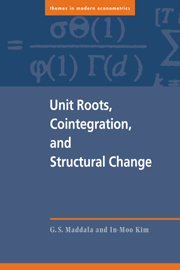Book contents
- Frontmatter
- Contents
- Figures
- Tables
- Dedication
- Preface
- Part I Introduction and basic concepts
- Part II Unit roots and cointegration
- Part III Extensions of the basic model
- 8 The Bayesian analysis of stochastic trends
- 9 Fractional unit roots and fractional cointegration
- 10 Small sample inference: bootstrap methods
- 11 Cointegrated systems with I(2) variables
- 12 Seasonal unit roots and seasonal cointegration
- Part IV Structural change
- Appendix 1 A brief guide to asymptotic theory
- Author index
- Subject index
12 - Seasonal unit roots and seasonal cointegration
Published online by Cambridge University Press: 04 August 2010
- Frontmatter
- Contents
- Figures
- Tables
- Dedication
- Preface
- Part I Introduction and basic concepts
- Part II Unit roots and cointegration
- Part III Extensions of the basic model
- 8 The Bayesian analysis of stochastic trends
- 9 Fractional unit roots and fractional cointegration
- 10 Small sample inference: bootstrap methods
- 11 Cointegrated systems with I(2) variables
- 12 Seasonal unit roots and seasonal cointegration
- Part IV Structural change
- Appendix 1 A brief guide to asymptotic theory
- Author index
- Subject index
Summary
As mentioned in chapter 2 and discussed in subsequent chapters, we have two types of trend: deterministic trend and stochastic trend. Similar is the case of seasonals: deterministic seasonal and stochastic seasonal. Deterministic seasonals are taken care of by seasonal dummies; stochastic seasonals are taken care of by differencing. For instance, with quarterly data we use Δ4yt = yt – yt–4 and with monthly data we use Δ12yt = yt – yt–12 if the seasonal is a stochastic seasonal. As with the operation of first-differences to take care of trends, the Box- Jenkins approach uses seasonal differences (with quarterly data it is fourth-difference, with monthly data it is twelfth-difference, and so on). Again the tests for seasonal roots is a formal generalization of this ad hoc procedure.
The paper by Davidson, Hendry, Srba, and Yeo (1978), to be referred to as DHSY, which used seasonal differences also had a strong influence on subsequent research that often used seasonal differences. The main focus of the paper by DHSY was the development of an appropriate econometric methodology for modeling dynamic relationships. After examining a number of different fomulations, these authors selected a model in which seasonal lags and seasonal differences played a prominent role. As with the concept of cointegration in models with stochastic trends, we have the concept of seasonal cointegration in models with stochastic seasonals. We shall discuss these concepts in what follows.
- Type
- Chapter
- Information
- Unit Roots, Cointegration, and Structural Change , pp. 362 - 386Publisher: Cambridge University PressPrint publication year: 1999



